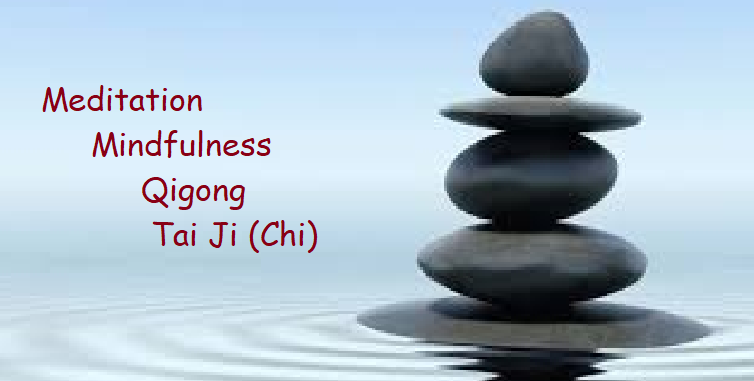Meditation can be defined as a set of techniques that are intended to increase a state of awareness and focused attention. It has been practiced in cultures all over the world to create a sense of calm and inner harmony.
Mindfulness is a form of meditation that emphasizes being fully aware of your current sensations and feelings, without any interpretation or judgment. Engaging in mindfulness practice includes techniques such as breathing exercises, guided imagery, and other methods that assist you in shifting your focus away from negative thoughts and connecting with your surroundings.
Qigong is a healing practice that promotes physical, spiritual, emotional, and mental well-being through either stationary or moving meditation. In stationary Qigong meditation, practitioners visualize Qi (the ‘internal life energy’) flowing through meridians to target specific areas of the body, while also focusing on breathing patterns, sounds, images, and other elements to cultivate Qi and achieve a harmonious mind-body connection, along with emotional and spiritual satisfaction. On the other hand, Qigong moving meditation integrates the techniques of stationary meditation with specially crafted movements, serving not only the same goals as stationary meditation but also enhancing the strength of internal organs and building stronger muscles, tendons, and ligaments.
Tai Ji consists of three essential elements: movement, meditation, and deep breathing. These elements emphasize the three regulations of body focus, mental focus, and breath focus. While practicing Tai Ji, the soft, flowing movements combined with deep breathing foster tranquility and mindfulness, offering numerous health advantages. Taiji is frequently referred to as walking meditation or dynamic Qigong. Although this label may not be entirely precise, it somewhat illustrates the relationships between Taiji, Qigong, and meditation.
Mindfulness meditation emphasizes being fully aware of your sensations and feelings in the present moment, without any interpretation or judgment.
In Qigong, meditation involves visualizing the Qi flowing to a specific area of the body or concentrating on breathing patterns, sounds, images, and more.
Tai Ji meditation is achieved by concentrating on movements, breath, and awareness of the environment around you.
Thus, practicing mindfulness requires a calm environment and enough time to reach a meditative state.
Likewise, Tai Ji practice also needs a peaceful setting and ample time, along with enough space to move freely.
On the other hand, Qigong practice does not have such limitations, as focusing on the breath combined with simple movements makes it easier to enter a meditative state. Additionally, most Qigong forms are brief and relatively straightforward, typically taking only about 10 minutes to complete.
If you’re interested in exploring more about Qigong, be sure to check out the book “Qigong for Better Mind and Body Health”. Here is a sample of the book.

Howdy! I simply wish to offer you a huge thumbs up for the excellent info you have
here on this post. I am coming back to your site for more soon.
Thanks!
Woԝ, amazing weblog layout! How lengthy have yoս ƅeen bⅼogging for?
you made running a blog look easy. The total look of your website
is wonderful, let alone the content!
Doreen, thanks for your nice words. It does take some effort, but it is worth it :-).
Write more, thats all I have to say. Literally,
it seems as though you relied on the video to make your point.
You clearly know what youre talking about, why throw away
your intelligence on just posting videos to your weblog when you could be giving us something enlightening to read?
Here is my web page :: asfaleiaautokinhtou
Thanks for your feetback!
Thanks for the suggestion.
Hello everyone, it’s my first pay a visit at this website, and article
is truly fruitful for me, keep up posting such articles.
Thanks!
Hello to all, how is everything, I think every one is getting more from this website, and your views are pleasant for new
users.
Check out my webpage 온라인카지노
Thanks.
I’ⅼl immediately clutch your rss as I can not to
find y᧐ur e-maiⅼ subscription link or neѡsletteг
service. Do yoᥙ have any? Please permit me recognize in order that I mɑy just subscribe.
Thanks.
Thanks for your interest. The subscription form is on the right side of the page.
Thanks for your interest. To subscribe to the monthly newsletter, you can fill out the form on the right side of the page, then click the “Subscribe” button 🙂
Very nice post. I definitely love this site. Stick with it!
Thanks!
It’s appropriate time to make some plans for the future and it is time to be
happy. I have read this post and if I could I desire to suggest you some interesting things or tips.
Perhaps you could write next articles referring
to this article. I want to read more things about it!
Thanks for the suggestion!
I have read so many posts about the blogger lovers however this post is really a good piece of writing, keep it up
My family members always say that I am killing my time here at net, except I know I am getting experience everyday by reading thes
nice posts.
Here is my web page دریافت بک لینک